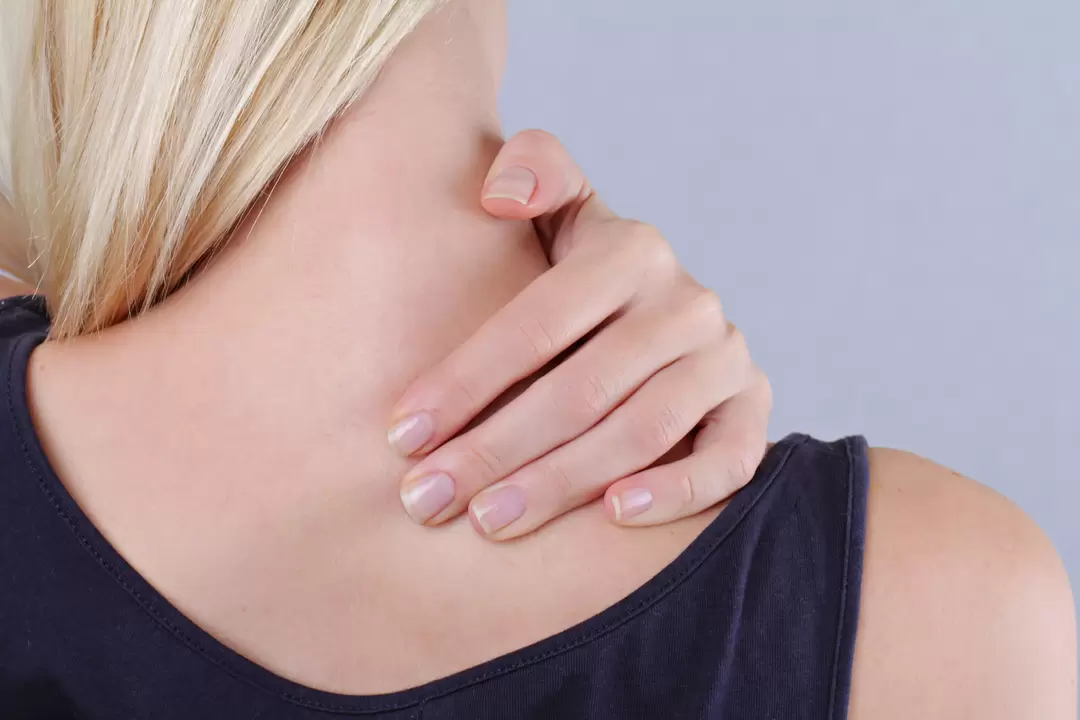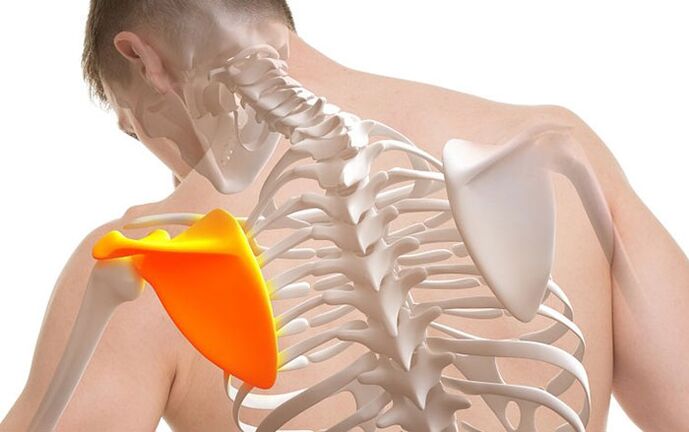
The most common diseases that cause pain behind the left shoulder blade are osteochondrosis, angina pectoris, pneumonia, peptic ulcer and panic attack. Along with pain syndrome, patients may experience nausea, vomiting, heartburn, coughing, sputum formation, and disturbances in sensory and motor functions. The diagnosis of patients' condition is based on surveys, examinations, laboratory and instrumental examinations. Treatment tactics depend on the cause of the disease.

Cause
Pain from behind to the back of the left shoulder is a frightening symptom that can be observed in diseases of the spine or severe impairment of internal organ function. However, in 7% of cases, such pain syndrome occurs due to a surgical pathology that requires urgent surgery.
The main causes of pain in the left scapular region include:
- Diseases of the spine (congenital disorders, ankylosing spondylitis, spondylosis, osteochondrosis, intervertebral hernia, etc. ) that provoke compression of the roots of the spine;
- Muscle pathologies (dermatomyositis, fibromyalgia, etc. ) that cause characteristic pain - myalgia;
- Neurological disorders (Guillain-Barré syndrome, polyneuropathy, intercostal neuralgia, etc. ) characterized by the appearance of specific neuropathic pain;
- Diseases of the internal organs:
- Hearts - angina pectoris, arrhythmia, heart attack;
- Pneumonia, pneumonia, tuberculosis, pleurisy;
- Gastritis - ulcers, ulcers;
- Spleen ruptures and other pathologies.
- "Blood cancer" (leukemia), which causes pain in the thickness of the bones that contain the bone marrow (pelvis, sternum, shoulder blades, tube bones).
Sometimes pain syndrome is triggered by disorders of the autonomic nervous system that regulates the work of all organs and systems. In such cases, we speak of an exacerbation of vegetovascular dystonia. e. about a panic attack.
Symptoms
The most common causes of left shoulder pain are osteochondrosis, angina pectoris, pneumonia, peptic ulcer, or panic attack.
Osteochondrosis
The disease is caused by the destruction of the intervertebral disc, which normally "softens" the movement of the spine. Usually, the pathology occurs in the background of extreme physical exertion and natural aging of the body.
So the destroyed intervertebral disc (often in the neck region) protrudes and damages the roots of the spine. Because of this, patients (on the side of the lesion) are concerned about the acute pain in the back of the head and neck that extends to the shoulder and shoulder area. Over time, surface sensitivity in these areas is disturbed, causing patients to not feel temperature and vibration on the skin.
As the disease progresses, the brachial plexus is involved in the pathological process, which makes shoulder mobility very difficult. However, the strength of the muscles of the affected arm is significantly weakened, leading to immobilization in advanced cases.
angina pectoris
Angina pectoris is a pain syndrome that occurs in the chest, also known as "angina pectoris. "The cause of the pain is a violation of the blood supply to the heart muscle due to the formation of vasoconstriction or cholesterol plaques in the lumen. It causes stress attacks, emotional and physical overload.
Usually, patients are concerned about sudden stinging or burning pain in the chest area. In this case, the pain often spreads toward the left scapula as well as along the ulnar surface of the left hand to the little finger. Pain syndrome is often accompanied by a feeling of heart failure and a fear of death.
Pneumonia
Pneumonia is often a disease caused by a bacterial or viral infection. In general, patients complain of a significant rise in temperature (up to 39, 5-40 ° C), fever, and "stinging" pain in the chest or shoulder blades from the affected lungs. In this case, the pain is exacerbated by sneezing, coughing, or intense breathing.
With the onset of the disease, a cough occurs and the purulent sputum separates, which sometimes gets a "rusty" character (due to blood contamination). Patients often experience shortness of breath and shortness of breath even with little physical activity.
peptic ulcer
The cause of the disease is local damage to the gastric mucosa with the development of peptic ulcer (i. e. , ulcers). The provocateurs are bacterial infection (Helicobacter), excessive acidity and gastric disorders.
The main complaint with peptic ulcer disease is paroxysmal pain in the upper abdomen (epigastrium) that occurs or gets worse after a meal. Exacerbation of the disease is often combined with nausea and vomiting, resulting in relief. During the interictal period, patients complain of heartburn, belching, bloating, and difficulty eating after eating.
Vegetative crisis
The cause of the pain may be a crisis of vegetovascular dystonia, also known as a panic attack. Usually, patients are concerned about the "migrating" pain that occurs either in the region of the heart or under the shoulder blade or in the abdomen, and so on.
At the same time, patients complain of fever, sweating, tremors, shortness of breath, fear of insanity, or confusion.
Such crises can be both organ (adrenal cancer, heart disease) and mental (phobias, depression, post-traumatic syndrome). In some cases, panic attacks are a consequence of taking medication.

Diagnostics
Diagnostic measures usually consist of:
- A survey to determine the occurrence and nature of pain;
- Clinical examination with clarification of pain localization and identification of pain points;
- Laboratory tests to detect infections (pneumonia or ulcers), inflammatory changes in blood or muscle protein levels that indicate their death (troponin in a heart attack);
- Instrumental methods using X-ray, ultrasound, CT or MRI.
Electrocardiography is also performed for myocardial infarction and fibrogastroduodenoscopy for gastric ulcers (endoscopic examination of the stomach).
Treatment
If there is back-to-back pain under the left scapula, patients should seek medical attention urgently because. such pain syndrome may indicate an emergency (myocardial infarction, splenic rupture, ulcer perforation, etc. ). In this case, it is not recommended to take painkillers because. Painkillers can hide symptoms and make later diagnosis more difficult!
- Osteochondrosis. Basic therapy includes non-steroidal and steroidal anti-inflammatory drugs. Muscle relaxants are used to relieve muscle cramps. Chondroprotectors are prescribed as a long-term treatment to slow the destruction of the intervertebral disc.
- Angina. The acute attack is relieved with nitrates. However, general therapy is based on lifestyle changes, acetylsalicylic acid (to "dilute" the blood), and the use of statins to lower cholesterol.
- Pneumonia. The main drug used to treat pneumonia is an antibiotic, the choice of which depends on the pathogen of the infection.
- Peptic ulcer. Treatment of an ulcer consists in killing the provocative bacteria (Helicobacter pylori). To this end, a number of antibacterial agents are prescribed, as well as drugs that reduce the level of acidity in the stomach contents.
- vegetative crisis. In most cases, the treatment of panic attacks can be limited to psychotherapy sessions. However, the appointment of psychotropic drugs (antidepressants, sedatives) is usually unjustified.
Preventive measures
Prevention of pain under the left shoulder from behind is based on:
- timely diagnosis of congenital and acquired diseases of the spine (fusion of cervical vertebrae, spondylosis, osteochondrosis, intervertebral hernia, injuries);
- early detection of muscle pathology (dermatomyositis, fibromyalgia);
- recovery of neurological disorders (intercostal neuralgia, polyneuropathy);
- treatment of diseases of internal organs:
- heart - angina pectoris, arrhythmia, heart attack;
- pneumonia, pneumonia, tuberculosis pleurisy;
- stomach - gastritis, ulcers, polyps;
- spleen ruptures and other pathologies.
- performing a blood screening test to diagnose leukemia before a symptom.
Keep in mind that left shoulder pain may indicate acute pathologies requiring emergency treatment or surgery.



































